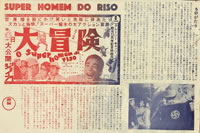From the community of fellow Japanese resident overseas to the "Colonia"
Determination to reside permanently and the Nisei education boom
Faced with the reality of not being able to make a living if they returned their homeland, the first generation Issei who dreamed of succeeding in Brazil and then returning back to Japan gave up on the idea of returning and determined to reside permanently in Brazil.
Once the determination to remain in Brazil was reached, there was a sudden increase in parents' enthusiasm for their children’s education in order to make sure they could attain higher social status. Parents and older siblings worked hard to ensure that younger siblings could attend university. The percentage of Japanese-Brazilians enrolled in higher education institutions increased tenfold, somewhat exceeding the national average. In those days most Japanese students selected colleges and universities which were linked to highly specialized professions such as law, medicine, dentistry, pharmacology, engineering and agronomy.
Nisei had grown up and many among them outstandingly succeeded in society, In 1954, Nisei Tamura Yukishige Tamura was elected to the House of Representatives.
Nisei problem
Together with this growth of Nisei came the bewilderment of the first generation Issei at how much different Nisei had become from them, and debates began on whether Nisei should be more Japanese or more Brazilian which came to be known as the "Nisei problem". Because what Japanese considered merits and strong points were not always thought highly of by Brazilians, Nisei who attempted to assimilate into Brazilian society, had found that being "not only a perfect Japanese but a good Brazilian" or "a Brazilian immersed in Japanese culture" which had been seen as an ideal in prewar days were not necessarily worth to themselves.
Relocation outside the state and centralization in urban areas
With the end of wartime restrictions, many Japanese moved undeveloped areas in other states including Parana, Mato Grosso and Goias, in order to expand the scope of their activities out of the State of São Paulo, where forests had been exhausted and soil had eroded due to the use of primitive exploitative farming. Others began to migrate to the area around the city of São Paulo to escape the conflict between the kachigumi and makegumi in outlying regions or to ensure that their children had better educational opportunities, resulting in a rapid increase in the number of family run laundries, barbershops and other independent businesses and those who practiced intensive agriculture targeted to consumers in large cities (planting of vegetables, fruits and poultry farming).
The Japanese population of São Paulo City grew nearly twenty-fold from 3,467 in 1939 to 62,000 in 1958.
From the community of resident fellows to the Colonia
From this period onwards, the Japanese immigrants community that had been consisted mainly of the first generation, Issei came to include the grown-up second generation, Nisei who had Brazilian citizenship. Since terms like "community of resident fellows" and "community of resident Japanese " no longer represented the actual situation, instead the Portuguese term "Colonia" (colony), which referred to an immigrant group coming from a foreign country, was adopted and the immigrants were called "colonia Japonesa" (Japanese colony or Nikkei colony).








